Cadbury Marketing Report: Exploring Roles, Marketing Mix, and Context
VerifiedAdded on 2021/02/19
|15
|4259
|31
Report
AI Summary
This report provides a comprehensive analysis of Cadbury's marketing strategies, focusing on the key roles and responsibilities within the marketing function, including market research, product development, and branding. It explores how these functions relate to the wider organizational context, examining the interdependencies between marketing and departments such as finance, human resources, sales, production, and research and development. The report also compares ways in which different organizations might apply the marketing mix. The report emphasizes the importance of consumer satisfaction, market planning, and the effective use of marketing tools to achieve organizational goals and objectives. The report also highlights the importance of branding, packaging, and consumer support services for Cadbury's success.

Marketing Essentials
Paraphrase This Document
Need a fresh take? Get an instant paraphrase of this document with our AI Paraphraser

Table of Contents
INTRODUCTION...........................................................................................................................3
TASK 1............................................................................................................................................3
P1 Key roles and responsibilities of the marketing function..................................................3
P2 Explain how roles and responsibilities of marketing relate to the wider organisational
context....................................................................................................................................5
TASK 2............................................................................................................................................8
P3 Compare ways in which different organisations apply the marketing mix to marketing
planning process.....................................................................................................................8
TASK 3..........................................................................................................................................11
Covered in PPT.....................................................................................................................11
CONCLUSION..............................................................................................................................11
REFERENCES .............................................................................................................................12
INTRODUCTION...........................................................................................................................3
TASK 1............................................................................................................................................3
P1 Key roles and responsibilities of the marketing function..................................................3
P2 Explain how roles and responsibilities of marketing relate to the wider organisational
context....................................................................................................................................5
TASK 2............................................................................................................................................8
P3 Compare ways in which different organisations apply the marketing mix to marketing
planning process.....................................................................................................................8
TASK 3..........................................................................................................................................11
Covered in PPT.....................................................................................................................11
CONCLUSION..............................................................................................................................11
REFERENCES .............................................................................................................................12
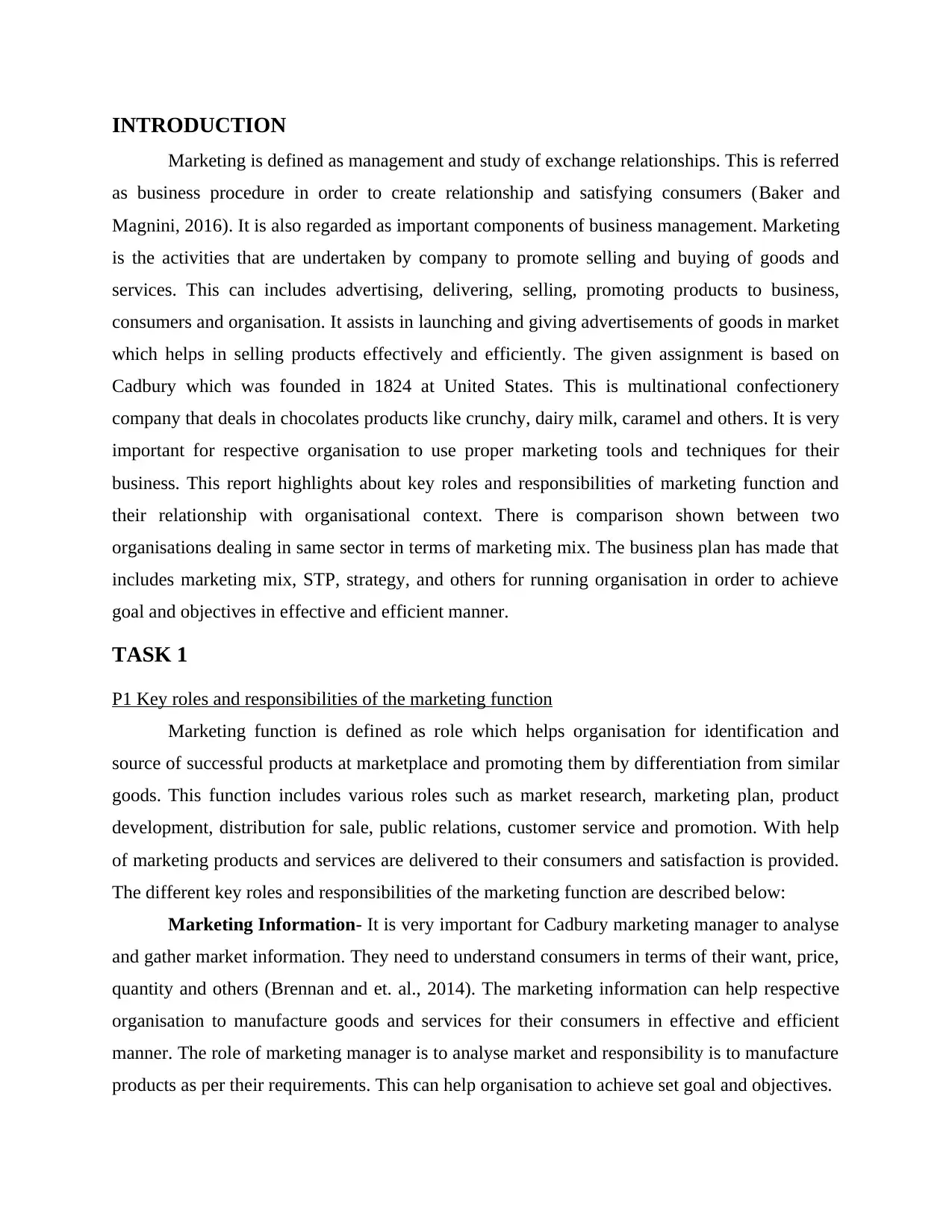
INTRODUCTION
Marketing is defined as management and study of exchange relationships. This is referred
as business procedure in order to create relationship and satisfying consumers (Baker and
Magnini, 2016). It is also regarded as important components of business management. Marketing
is the activities that are undertaken by company to promote selling and buying of goods and
services. This can includes advertising, delivering, selling, promoting products to business,
consumers and organisation. It assists in launching and giving advertisements of goods in market
which helps in selling products effectively and efficiently. The given assignment is based on
Cadbury which was founded in 1824 at United States. This is multinational confectionery
company that deals in chocolates products like crunchy, dairy milk, caramel and others. It is very
important for respective organisation to use proper marketing tools and techniques for their
business. This report highlights about key roles and responsibilities of marketing function and
their relationship with organisational context. There is comparison shown between two
organisations dealing in same sector in terms of marketing mix. The business plan has made that
includes marketing mix, STP, strategy, and others for running organisation in order to achieve
goal and objectives in effective and efficient manner.
TASK 1
P1 Key roles and responsibilities of the marketing function
Marketing function is defined as role which helps organisation for identification and
source of successful products at marketplace and promoting them by differentiation from similar
goods. This function includes various roles such as market research, marketing plan, product
development, distribution for sale, public relations, customer service and promotion. With help
of marketing products and services are delivered to their consumers and satisfaction is provided.
The different key roles and responsibilities of the marketing function are described below:
Marketing Information- It is very important for Cadbury marketing manager to analyse
and gather market information. They need to understand consumers in terms of their want, price,
quantity and others (Brennan and et. al., 2014). The marketing information can help respective
organisation to manufacture goods and services for their consumers in effective and efficient
manner. The role of marketing manager is to analyse market and responsibility is to manufacture
products as per their requirements. This can help organisation to achieve set goal and objectives.
Marketing is defined as management and study of exchange relationships. This is referred
as business procedure in order to create relationship and satisfying consumers (Baker and
Magnini, 2016). It is also regarded as important components of business management. Marketing
is the activities that are undertaken by company to promote selling and buying of goods and
services. This can includes advertising, delivering, selling, promoting products to business,
consumers and organisation. It assists in launching and giving advertisements of goods in market
which helps in selling products effectively and efficiently. The given assignment is based on
Cadbury which was founded in 1824 at United States. This is multinational confectionery
company that deals in chocolates products like crunchy, dairy milk, caramel and others. It is very
important for respective organisation to use proper marketing tools and techniques for their
business. This report highlights about key roles and responsibilities of marketing function and
their relationship with organisational context. There is comparison shown between two
organisations dealing in same sector in terms of marketing mix. The business plan has made that
includes marketing mix, STP, strategy, and others for running organisation in order to achieve
goal and objectives in effective and efficient manner.
TASK 1
P1 Key roles and responsibilities of the marketing function
Marketing function is defined as role which helps organisation for identification and
source of successful products at marketplace and promoting them by differentiation from similar
goods. This function includes various roles such as market research, marketing plan, product
development, distribution for sale, public relations, customer service and promotion. With help
of marketing products and services are delivered to their consumers and satisfaction is provided.
The different key roles and responsibilities of the marketing function are described below:
Marketing Information- It is very important for Cadbury marketing manager to analyse
and gather market information. They need to understand consumers in terms of their want, price,
quantity and others (Brennan and et. al., 2014). The marketing information can help respective
organisation to manufacture goods and services for their consumers in effective and efficient
manner. The role of marketing manager is to analyse market and responsibility is to manufacture
products as per their requirements. This can help organisation to achieve set goal and objectives.
⊘ This is a preview!⊘
Do you want full access?
Subscribe today to unlock all pages.

Trusted by 1+ million students worldwide
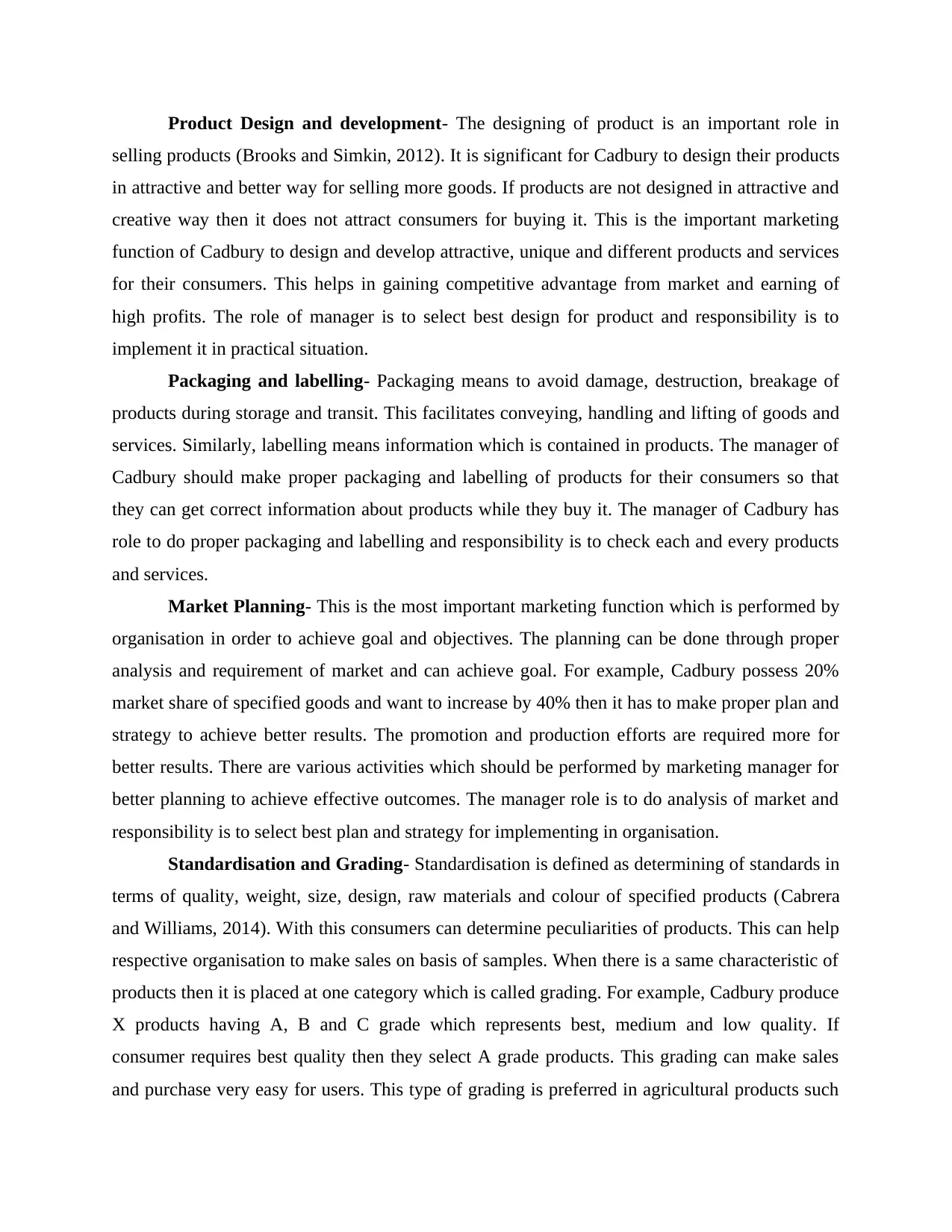
Product Design and development- The designing of product is an important role in
selling products (Brooks and Simkin, 2012). It is significant for Cadbury to design their products
in attractive and better way for selling more goods. If products are not designed in attractive and
creative way then it does not attract consumers for buying it. This is the important marketing
function of Cadbury to design and develop attractive, unique and different products and services
for their consumers. This helps in gaining competitive advantage from market and earning of
high profits. The role of manager is to select best design for product and responsibility is to
implement it in practical situation.
Packaging and labelling- Packaging means to avoid damage, destruction, breakage of
products during storage and transit. This facilitates conveying, handling and lifting of goods and
services. Similarly, labelling means information which is contained in products. The manager of
Cadbury should make proper packaging and labelling of products for their consumers so that
they can get correct information about products while they buy it. The manager of Cadbury has
role to do proper packaging and labelling and responsibility is to check each and every products
and services.
Market Planning- This is the most important marketing function which is performed by
organisation in order to achieve goal and objectives. The planning can be done through proper
analysis and requirement of market and can achieve goal. For example, Cadbury possess 20%
market share of specified goods and want to increase by 40% then it has to make proper plan and
strategy to achieve better results. The promotion and production efforts are required more for
better results. There are various activities which should be performed by marketing manager for
better planning to achieve effective outcomes. The manager role is to do analysis of market and
responsibility is to select best plan and strategy for implementing in organisation.
Standardisation and Grading- Standardisation is defined as determining of standards in
terms of quality, weight, size, design, raw materials and colour of specified products (Cabrera
and Williams, 2014). With this consumers can determine peculiarities of products. This can help
respective organisation to make sales on basis of samples. When there is a same characteristic of
products then it is placed at one category which is called grading. For example, Cadbury produce
X products having A, B and C grade which represents best, medium and low quality. If
consumer requires best quality then they select A grade products. This grading can make sales
and purchase very easy for users. This type of grading is preferred in agricultural products such
selling products (Brooks and Simkin, 2012). It is significant for Cadbury to design their products
in attractive and better way for selling more goods. If products are not designed in attractive and
creative way then it does not attract consumers for buying it. This is the important marketing
function of Cadbury to design and develop attractive, unique and different products and services
for their consumers. This helps in gaining competitive advantage from market and earning of
high profits. The role of manager is to select best design for product and responsibility is to
implement it in practical situation.
Packaging and labelling- Packaging means to avoid damage, destruction, breakage of
products during storage and transit. This facilitates conveying, handling and lifting of goods and
services. Similarly, labelling means information which is contained in products. The manager of
Cadbury should make proper packaging and labelling of products for their consumers so that
they can get correct information about products while they buy it. The manager of Cadbury has
role to do proper packaging and labelling and responsibility is to check each and every products
and services.
Market Planning- This is the most important marketing function which is performed by
organisation in order to achieve goal and objectives. The planning can be done through proper
analysis and requirement of market and can achieve goal. For example, Cadbury possess 20%
market share of specified goods and want to increase by 40% then it has to make proper plan and
strategy to achieve better results. The promotion and production efforts are required more for
better results. There are various activities which should be performed by marketing manager for
better planning to achieve effective outcomes. The manager role is to do analysis of market and
responsibility is to select best plan and strategy for implementing in organisation.
Standardisation and Grading- Standardisation is defined as determining of standards in
terms of quality, weight, size, design, raw materials and colour of specified products (Cabrera
and Williams, 2014). With this consumers can determine peculiarities of products. This can help
respective organisation to make sales on basis of samples. When there is a same characteristic of
products then it is placed at one category which is called grading. For example, Cadbury produce
X products having A, B and C grade which represents best, medium and low quality. If
consumer requires best quality then they select A grade products. This grading can make sales
and purchase very easy for users. This type of grading is preferred in agricultural products such
Paraphrase This Document
Need a fresh take? Get an instant paraphrase of this document with our AI Paraphraser
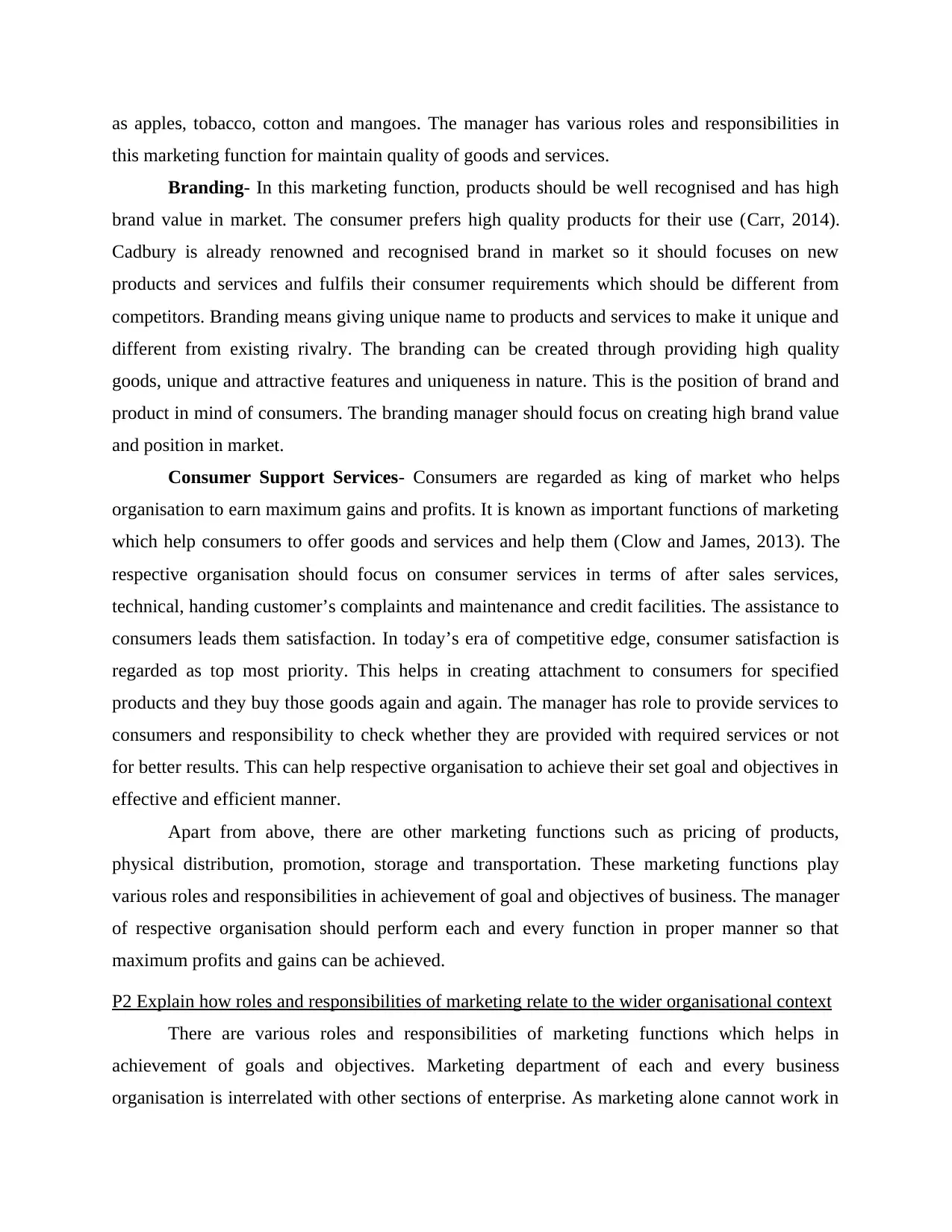
as apples, tobacco, cotton and mangoes. The manager has various roles and responsibilities in
this marketing function for maintain quality of goods and services.
Branding- In this marketing function, products should be well recognised and has high
brand value in market. The consumer prefers high quality products for their use (Carr, 2014).
Cadbury is already renowned and recognised brand in market so it should focuses on new
products and services and fulfils their consumer requirements which should be different from
competitors. Branding means giving unique name to products and services to make it unique and
different from existing rivalry. The branding can be created through providing high quality
goods, unique and attractive features and uniqueness in nature. This is the position of brand and
product in mind of consumers. The branding manager should focus on creating high brand value
and position in market.
Consumer Support Services- Consumers are regarded as king of market who helps
organisation to earn maximum gains and profits. It is known as important functions of marketing
which help consumers to offer goods and services and help them (Clow and James, 2013). The
respective organisation should focus on consumer services in terms of after sales services,
technical, handing customer’s complaints and maintenance and credit facilities. The assistance to
consumers leads them satisfaction. In today’s era of competitive edge, consumer satisfaction is
regarded as top most priority. This helps in creating attachment to consumers for specified
products and they buy those goods again and again. The manager has role to provide services to
consumers and responsibility to check whether they are provided with required services or not
for better results. This can help respective organisation to achieve their set goal and objectives in
effective and efficient manner.
Apart from above, there are other marketing functions such as pricing of products,
physical distribution, promotion, storage and transportation. These marketing functions play
various roles and responsibilities in achievement of goal and objectives of business. The manager
of respective organisation should perform each and every function in proper manner so that
maximum profits and gains can be achieved.
P2 Explain how roles and responsibilities of marketing relate to the wider organisational context
There are various roles and responsibilities of marketing functions which helps in
achievement of goals and objectives. Marketing department of each and every business
organisation is interrelated with other sections of enterprise. As marketing alone cannot work in
this marketing function for maintain quality of goods and services.
Branding- In this marketing function, products should be well recognised and has high
brand value in market. The consumer prefers high quality products for their use (Carr, 2014).
Cadbury is already renowned and recognised brand in market so it should focuses on new
products and services and fulfils their consumer requirements which should be different from
competitors. Branding means giving unique name to products and services to make it unique and
different from existing rivalry. The branding can be created through providing high quality
goods, unique and attractive features and uniqueness in nature. This is the position of brand and
product in mind of consumers. The branding manager should focus on creating high brand value
and position in market.
Consumer Support Services- Consumers are regarded as king of market who helps
organisation to earn maximum gains and profits. It is known as important functions of marketing
which help consumers to offer goods and services and help them (Clow and James, 2013). The
respective organisation should focus on consumer services in terms of after sales services,
technical, handing customer’s complaints and maintenance and credit facilities. The assistance to
consumers leads them satisfaction. In today’s era of competitive edge, consumer satisfaction is
regarded as top most priority. This helps in creating attachment to consumers for specified
products and they buy those goods again and again. The manager has role to provide services to
consumers and responsibility to check whether they are provided with required services or not
for better results. This can help respective organisation to achieve their set goal and objectives in
effective and efficient manner.
Apart from above, there are other marketing functions such as pricing of products,
physical distribution, promotion, storage and transportation. These marketing functions play
various roles and responsibilities in achievement of goal and objectives of business. The manager
of respective organisation should perform each and every function in proper manner so that
maximum profits and gains can be achieved.
P2 Explain how roles and responsibilities of marketing relate to the wider organisational context
There are various roles and responsibilities of marketing functions which helps in
achievement of goals and objectives. Marketing department of each and every business
organisation is interrelated with other sections of enterprise. As marketing alone cannot work in
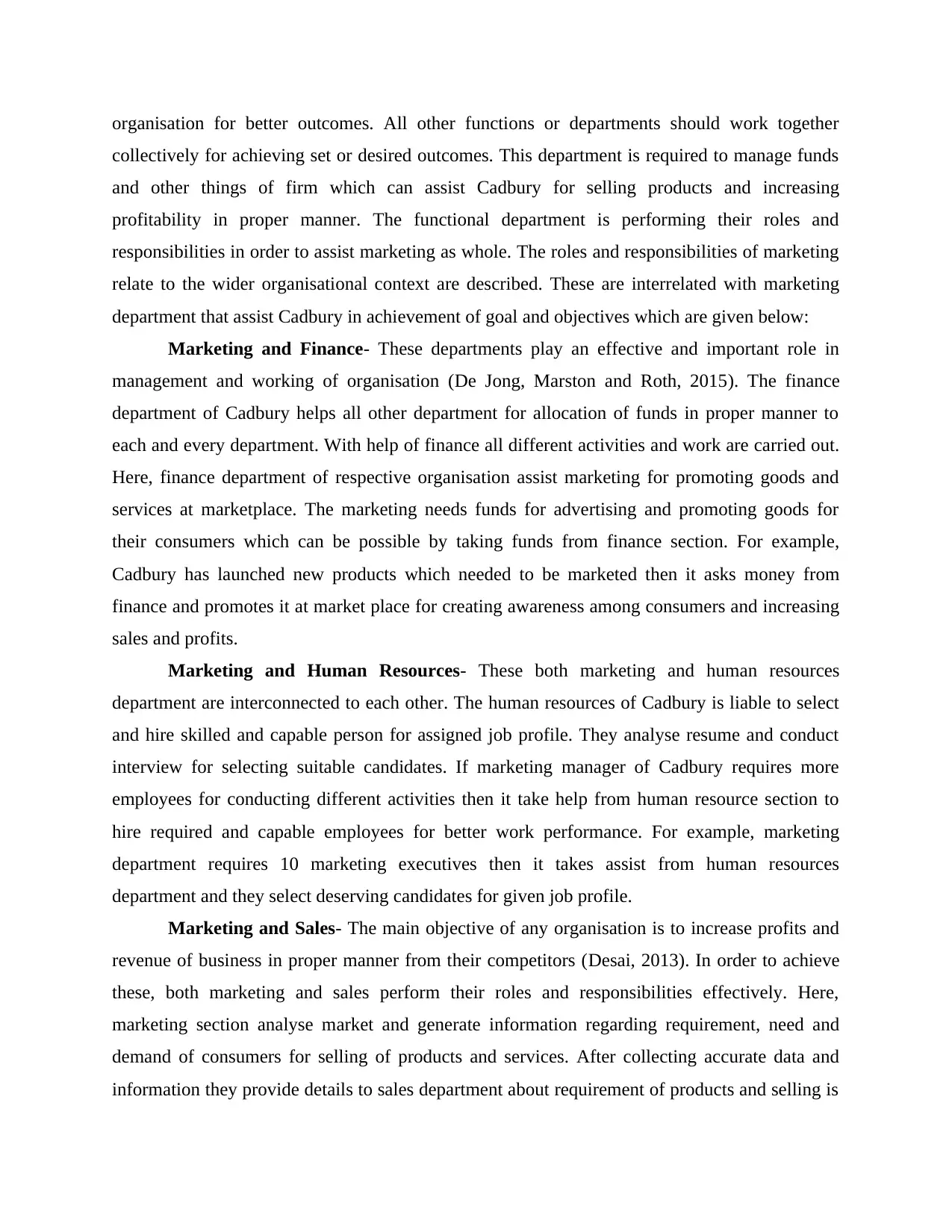
organisation for better outcomes. All other functions or departments should work together
collectively for achieving set or desired outcomes. This department is required to manage funds
and other things of firm which can assist Cadbury for selling products and increasing
profitability in proper manner. The functional department is performing their roles and
responsibilities in order to assist marketing as whole. The roles and responsibilities of marketing
relate to the wider organisational context are described. These are interrelated with marketing
department that assist Cadbury in achievement of goal and objectives which are given below:
Marketing and Finance- These departments play an effective and important role in
management and working of organisation (De Jong, Marston and Roth, 2015). The finance
department of Cadbury helps all other department for allocation of funds in proper manner to
each and every department. With help of finance all different activities and work are carried out.
Here, finance department of respective organisation assist marketing for promoting goods and
services at marketplace. The marketing needs funds for advertising and promoting goods for
their consumers which can be possible by taking funds from finance section. For example,
Cadbury has launched new products which needed to be marketed then it asks money from
finance and promotes it at market place for creating awareness among consumers and increasing
sales and profits.
Marketing and Human Resources- These both marketing and human resources
department are interconnected to each other. The human resources of Cadbury is liable to select
and hire skilled and capable person for assigned job profile. They analyse resume and conduct
interview for selecting suitable candidates. If marketing manager of Cadbury requires more
employees for conducting different activities then it take help from human resource section to
hire required and capable employees for better work performance. For example, marketing
department requires 10 marketing executives then it takes assist from human resources
department and they select deserving candidates for given job profile.
Marketing and Sales- The main objective of any organisation is to increase profits and
revenue of business in proper manner from their competitors (Desai, 2013). In order to achieve
these, both marketing and sales perform their roles and responsibilities effectively. Here,
marketing section analyse market and generate information regarding requirement, need and
demand of consumers for selling of products and services. After collecting accurate data and
information they provide details to sales department about requirement of products and selling is
collectively for achieving set or desired outcomes. This department is required to manage funds
and other things of firm which can assist Cadbury for selling products and increasing
profitability in proper manner. The functional department is performing their roles and
responsibilities in order to assist marketing as whole. The roles and responsibilities of marketing
relate to the wider organisational context are described. These are interrelated with marketing
department that assist Cadbury in achievement of goal and objectives which are given below:
Marketing and Finance- These departments play an effective and important role in
management and working of organisation (De Jong, Marston and Roth, 2015). The finance
department of Cadbury helps all other department for allocation of funds in proper manner to
each and every department. With help of finance all different activities and work are carried out.
Here, finance department of respective organisation assist marketing for promoting goods and
services at marketplace. The marketing needs funds for advertising and promoting goods for
their consumers which can be possible by taking funds from finance section. For example,
Cadbury has launched new products which needed to be marketed then it asks money from
finance and promotes it at market place for creating awareness among consumers and increasing
sales and profits.
Marketing and Human Resources- These both marketing and human resources
department are interconnected to each other. The human resources of Cadbury is liable to select
and hire skilled and capable person for assigned job profile. They analyse resume and conduct
interview for selecting suitable candidates. If marketing manager of Cadbury requires more
employees for conducting different activities then it take help from human resource section to
hire required and capable employees for better work performance. For example, marketing
department requires 10 marketing executives then it takes assist from human resources
department and they select deserving candidates for given job profile.
Marketing and Sales- The main objective of any organisation is to increase profits and
revenue of business in proper manner from their competitors (Desai, 2013). In order to achieve
these, both marketing and sales perform their roles and responsibilities effectively. Here,
marketing section analyse market and generate information regarding requirement, need and
demand of consumers for selling of products and services. After collecting accurate data and
information they provide details to sales department about requirement of products and selling is
⊘ This is a preview!⊘
Do you want full access?
Subscribe today to unlock all pages.

Trusted by 1+ million students worldwide
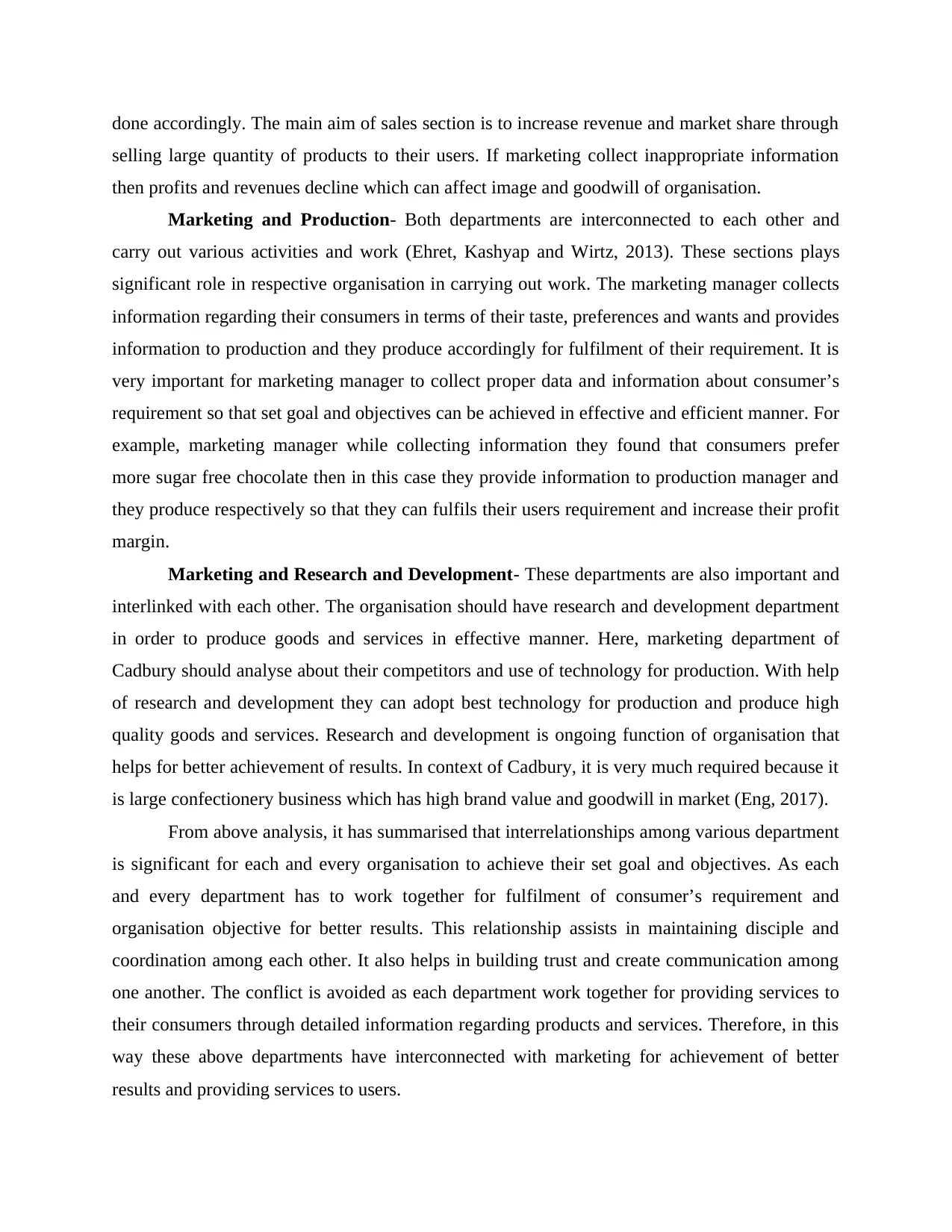
done accordingly. The main aim of sales section is to increase revenue and market share through
selling large quantity of products to their users. If marketing collect inappropriate information
then profits and revenues decline which can affect image and goodwill of organisation.
Marketing and Production- Both departments are interconnected to each other and
carry out various activities and work (Ehret, Kashyap and Wirtz, 2013). These sections plays
significant role in respective organisation in carrying out work. The marketing manager collects
information regarding their consumers in terms of their taste, preferences and wants and provides
information to production and they produce accordingly for fulfilment of their requirement. It is
very important for marketing manager to collect proper data and information about consumer’s
requirement so that set goal and objectives can be achieved in effective and efficient manner. For
example, marketing manager while collecting information they found that consumers prefer
more sugar free chocolate then in this case they provide information to production manager and
they produce respectively so that they can fulfils their users requirement and increase their profit
margin.
Marketing and Research and Development- These departments are also important and
interlinked with each other. The organisation should have research and development department
in order to produce goods and services in effective manner. Here, marketing department of
Cadbury should analyse about their competitors and use of technology for production. With help
of research and development they can adopt best technology for production and produce high
quality goods and services. Research and development is ongoing function of organisation that
helps for better achievement of results. In context of Cadbury, it is very much required because it
is large confectionery business which has high brand value and goodwill in market (Eng, 2017).
From above analysis, it has summarised that interrelationships among various department
is significant for each and every organisation to achieve their set goal and objectives. As each
and every department has to work together for fulfilment of consumer’s requirement and
organisation objective for better results. This relationship assists in maintaining disciple and
coordination among each other. It also helps in building trust and create communication among
one another. The conflict is avoided as each department work together for providing services to
their consumers through detailed information regarding products and services. Therefore, in this
way these above departments have interconnected with marketing for achievement of better
results and providing services to users.
selling large quantity of products to their users. If marketing collect inappropriate information
then profits and revenues decline which can affect image and goodwill of organisation.
Marketing and Production- Both departments are interconnected to each other and
carry out various activities and work (Ehret, Kashyap and Wirtz, 2013). These sections plays
significant role in respective organisation in carrying out work. The marketing manager collects
information regarding their consumers in terms of their taste, preferences and wants and provides
information to production and they produce accordingly for fulfilment of their requirement. It is
very important for marketing manager to collect proper data and information about consumer’s
requirement so that set goal and objectives can be achieved in effective and efficient manner. For
example, marketing manager while collecting information they found that consumers prefer
more sugar free chocolate then in this case they provide information to production manager and
they produce respectively so that they can fulfils their users requirement and increase their profit
margin.
Marketing and Research and Development- These departments are also important and
interlinked with each other. The organisation should have research and development department
in order to produce goods and services in effective manner. Here, marketing department of
Cadbury should analyse about their competitors and use of technology for production. With help
of research and development they can adopt best technology for production and produce high
quality goods and services. Research and development is ongoing function of organisation that
helps for better achievement of results. In context of Cadbury, it is very much required because it
is large confectionery business which has high brand value and goodwill in market (Eng, 2017).
From above analysis, it has summarised that interrelationships among various department
is significant for each and every organisation to achieve their set goal and objectives. As each
and every department has to work together for fulfilment of consumer’s requirement and
organisation objective for better results. This relationship assists in maintaining disciple and
coordination among each other. It also helps in building trust and create communication among
one another. The conflict is avoided as each department work together for providing services to
their consumers through detailed information regarding products and services. Therefore, in this
way these above departments have interconnected with marketing for achievement of better
results and providing services to users.
Paraphrase This Document
Need a fresh take? Get an instant paraphrase of this document with our AI Paraphraser
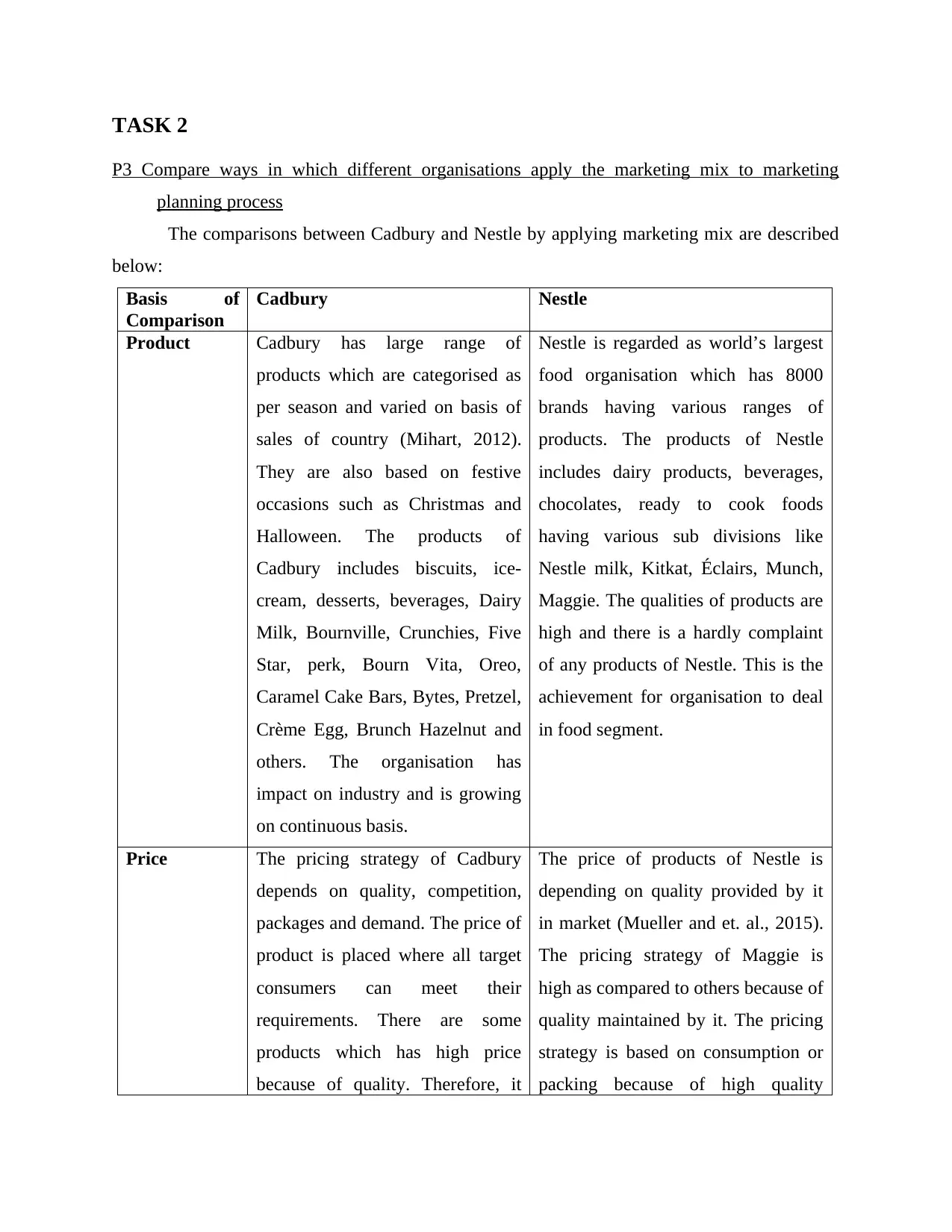
TASK 2
P3 Compare ways in which different organisations apply the marketing mix to marketing
planning process
The comparisons between Cadbury and Nestle by applying marketing mix are described
below:
Basis of
Comparison
Cadbury Nestle
Product Cadbury has large range of
products which are categorised as
per season and varied on basis of
sales of country (Mihart, 2012).
They are also based on festive
occasions such as Christmas and
Halloween. The products of
Cadbury includes biscuits, ice-
cream, desserts, beverages, Dairy
Milk, Bournville, Crunchies, Five
Star, perk, Bourn Vita, Oreo,
Caramel Cake Bars, Bytes, Pretzel,
Crème Egg, Brunch Hazelnut and
others. The organisation has
impact on industry and is growing
on continuous basis.
Nestle is regarded as world’s largest
food organisation which has 8000
brands having various ranges of
products. The products of Nestle
includes dairy products, beverages,
chocolates, ready to cook foods
having various sub divisions like
Nestle milk, Kitkat, Éclairs, Munch,
Maggie. The qualities of products are
high and there is a hardly complaint
of any products of Nestle. This is the
achievement for organisation to deal
in food segment.
Price The pricing strategy of Cadbury
depends on quality, competition,
packages and demand. The price of
product is placed where all target
consumers can meet their
requirements. There are some
products which has high price
because of quality. Therefore, it
The price of products of Nestle is
depending on quality provided by it
in market (Mueller and et. al., 2015).
The pricing strategy of Maggie is
high as compared to others because of
quality maintained by it. The pricing
strategy is based on consumption or
packing because of high quality
P3 Compare ways in which different organisations apply the marketing mix to marketing
planning process
The comparisons between Cadbury and Nestle by applying marketing mix are described
below:
Basis of
Comparison
Cadbury Nestle
Product Cadbury has large range of
products which are categorised as
per season and varied on basis of
sales of country (Mihart, 2012).
They are also based on festive
occasions such as Christmas and
Halloween. The products of
Cadbury includes biscuits, ice-
cream, desserts, beverages, Dairy
Milk, Bournville, Crunchies, Five
Star, perk, Bourn Vita, Oreo,
Caramel Cake Bars, Bytes, Pretzel,
Crème Egg, Brunch Hazelnut and
others. The organisation has
impact on industry and is growing
on continuous basis.
Nestle is regarded as world’s largest
food organisation which has 8000
brands having various ranges of
products. The products of Nestle
includes dairy products, beverages,
chocolates, ready to cook foods
having various sub divisions like
Nestle milk, Kitkat, Éclairs, Munch,
Maggie. The qualities of products are
high and there is a hardly complaint
of any products of Nestle. This is the
achievement for organisation to deal
in food segment.
Price The pricing strategy of Cadbury
depends on quality, competition,
packages and demand. The price of
product is placed where all target
consumers can meet their
requirements. There are some
products which has high price
because of quality. Therefore, it
The price of products of Nestle is
depending on quality provided by it
in market (Mueller and et. al., 2015).
The pricing strategy of Maggie is
high as compared to others because of
quality maintained by it. The pricing
strategy is based on consumption or
packing because of high quality
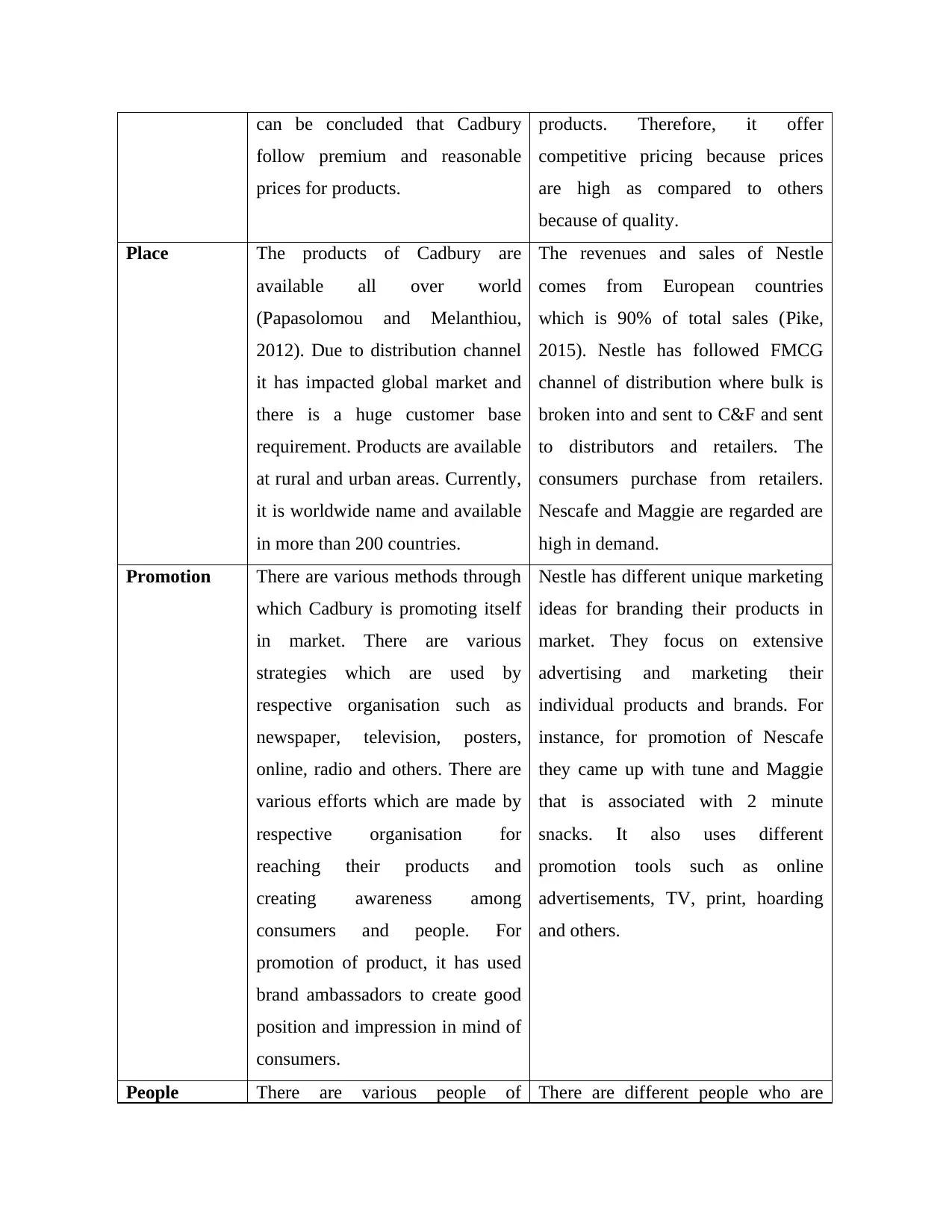
can be concluded that Cadbury
follow premium and reasonable
prices for products.
products. Therefore, it offer
competitive pricing because prices
are high as compared to others
because of quality.
Place The products of Cadbury are
available all over world
(Papasolomou and Melanthiou,
2012). Due to distribution channel
it has impacted global market and
there is a huge customer base
requirement. Products are available
at rural and urban areas. Currently,
it is worldwide name and available
in more than 200 countries.
The revenues and sales of Nestle
comes from European countries
which is 90% of total sales (Pike,
2015). Nestle has followed FMCG
channel of distribution where bulk is
broken into and sent to C&F and sent
to distributors and retailers. The
consumers purchase from retailers.
Nescafe and Maggie are regarded are
high in demand.
Promotion There are various methods through
which Cadbury is promoting itself
in market. There are various
strategies which are used by
respective organisation such as
newspaper, television, posters,
online, radio and others. There are
various efforts which are made by
respective organisation for
reaching their products and
creating awareness among
consumers and people. For
promotion of product, it has used
brand ambassadors to create good
position and impression in mind of
consumers.
Nestle has different unique marketing
ideas for branding their products in
market. They focus on extensive
advertising and marketing their
individual products and brands. For
instance, for promotion of Nescafe
they came up with tune and Maggie
that is associated with 2 minute
snacks. It also uses different
promotion tools such as online
advertisements, TV, print, hoarding
and others.
People There are various people of There are different people who are
follow premium and reasonable
prices for products.
products. Therefore, it offer
competitive pricing because prices
are high as compared to others
because of quality.
Place The products of Cadbury are
available all over world
(Papasolomou and Melanthiou,
2012). Due to distribution channel
it has impacted global market and
there is a huge customer base
requirement. Products are available
at rural and urban areas. Currently,
it is worldwide name and available
in more than 200 countries.
The revenues and sales of Nestle
comes from European countries
which is 90% of total sales (Pike,
2015). Nestle has followed FMCG
channel of distribution where bulk is
broken into and sent to C&F and sent
to distributors and retailers. The
consumers purchase from retailers.
Nescafe and Maggie are regarded are
high in demand.
Promotion There are various methods through
which Cadbury is promoting itself
in market. There are various
strategies which are used by
respective organisation such as
newspaper, television, posters,
online, radio and others. There are
various efforts which are made by
respective organisation for
reaching their products and
creating awareness among
consumers and people. For
promotion of product, it has used
brand ambassadors to create good
position and impression in mind of
consumers.
Nestle has different unique marketing
ideas for branding their products in
market. They focus on extensive
advertising and marketing their
individual products and brands. For
instance, for promotion of Nescafe
they came up with tune and Maggie
that is associated with 2 minute
snacks. It also uses different
promotion tools such as online
advertisements, TV, print, hoarding
and others.
People There are various people of There are different people who are
⊘ This is a preview!⊘
Do you want full access?
Subscribe today to unlock all pages.

Trusted by 1+ million students worldwide
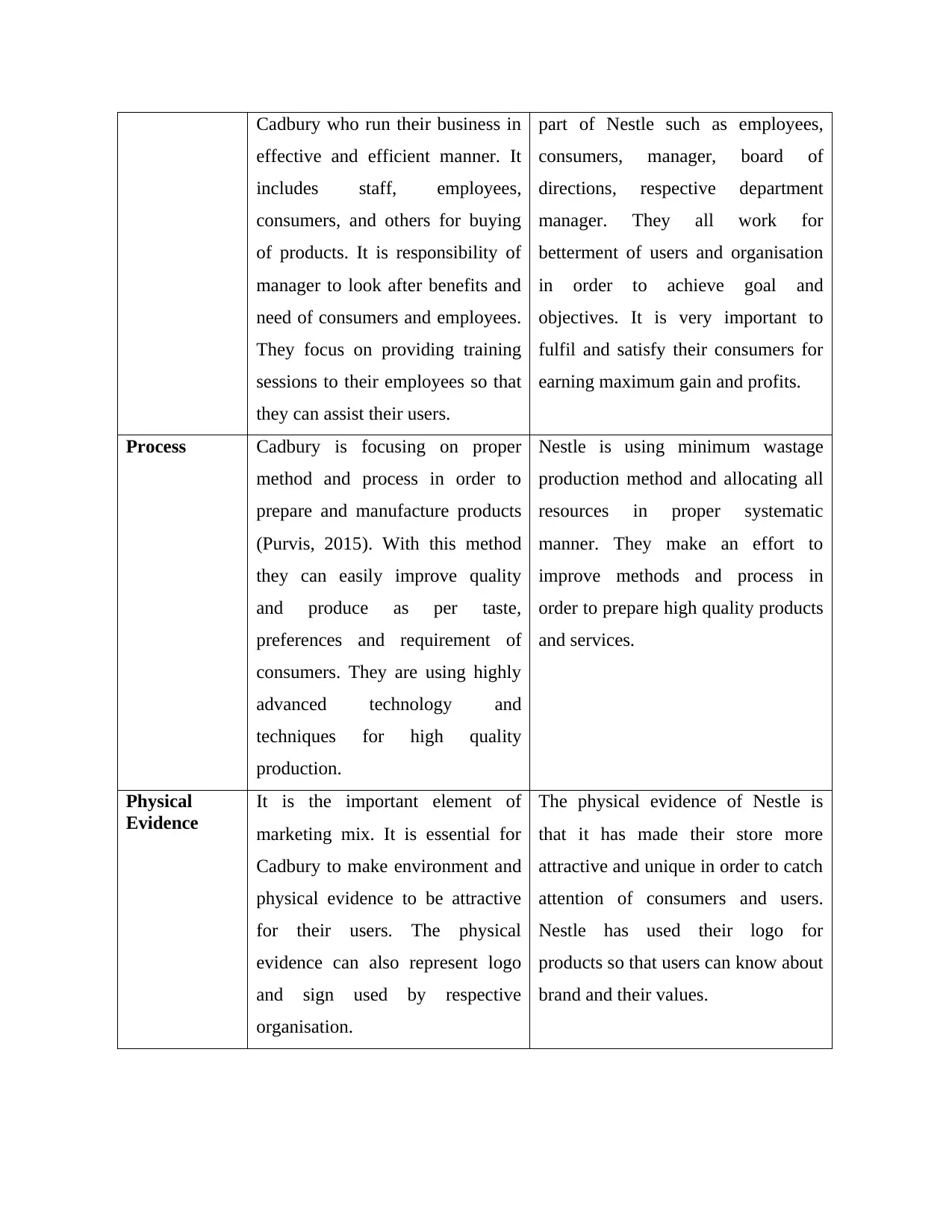
Cadbury who run their business in
effective and efficient manner. It
includes staff, employees,
consumers, and others for buying
of products. It is responsibility of
manager to look after benefits and
need of consumers and employees.
They focus on providing training
sessions to their employees so that
they can assist their users.
part of Nestle such as employees,
consumers, manager, board of
directions, respective department
manager. They all work for
betterment of users and organisation
in order to achieve goal and
objectives. It is very important to
fulfil and satisfy their consumers for
earning maximum gain and profits.
Process Cadbury is focusing on proper
method and process in order to
prepare and manufacture products
(Purvis, 2015). With this method
they can easily improve quality
and produce as per taste,
preferences and requirement of
consumers. They are using highly
advanced technology and
techniques for high quality
production.
Nestle is using minimum wastage
production method and allocating all
resources in proper systematic
manner. They make an effort to
improve methods and process in
order to prepare high quality products
and services.
Physical
Evidence
It is the important element of
marketing mix. It is essential for
Cadbury to make environment and
physical evidence to be attractive
for their users. The physical
evidence can also represent logo
and sign used by respective
organisation.
The physical evidence of Nestle is
that it has made their store more
attractive and unique in order to catch
attention of consumers and users.
Nestle has used their logo for
products so that users can know about
brand and their values.
effective and efficient manner. It
includes staff, employees,
consumers, and others for buying
of products. It is responsibility of
manager to look after benefits and
need of consumers and employees.
They focus on providing training
sessions to their employees so that
they can assist their users.
part of Nestle such as employees,
consumers, manager, board of
directions, respective department
manager. They all work for
betterment of users and organisation
in order to achieve goal and
objectives. It is very important to
fulfil and satisfy their consumers for
earning maximum gain and profits.
Process Cadbury is focusing on proper
method and process in order to
prepare and manufacture products
(Purvis, 2015). With this method
they can easily improve quality
and produce as per taste,
preferences and requirement of
consumers. They are using highly
advanced technology and
techniques for high quality
production.
Nestle is using minimum wastage
production method and allocating all
resources in proper systematic
manner. They make an effort to
improve methods and process in
order to prepare high quality products
and services.
Physical
Evidence
It is the important element of
marketing mix. It is essential for
Cadbury to make environment and
physical evidence to be attractive
for their users. The physical
evidence can also represent logo
and sign used by respective
organisation.
The physical evidence of Nestle is
that it has made their store more
attractive and unique in order to catch
attention of consumers and users.
Nestle has used their logo for
products so that users can know about
brand and their values.
Paraphrase This Document
Need a fresh take? Get an instant paraphrase of this document with our AI Paraphraser
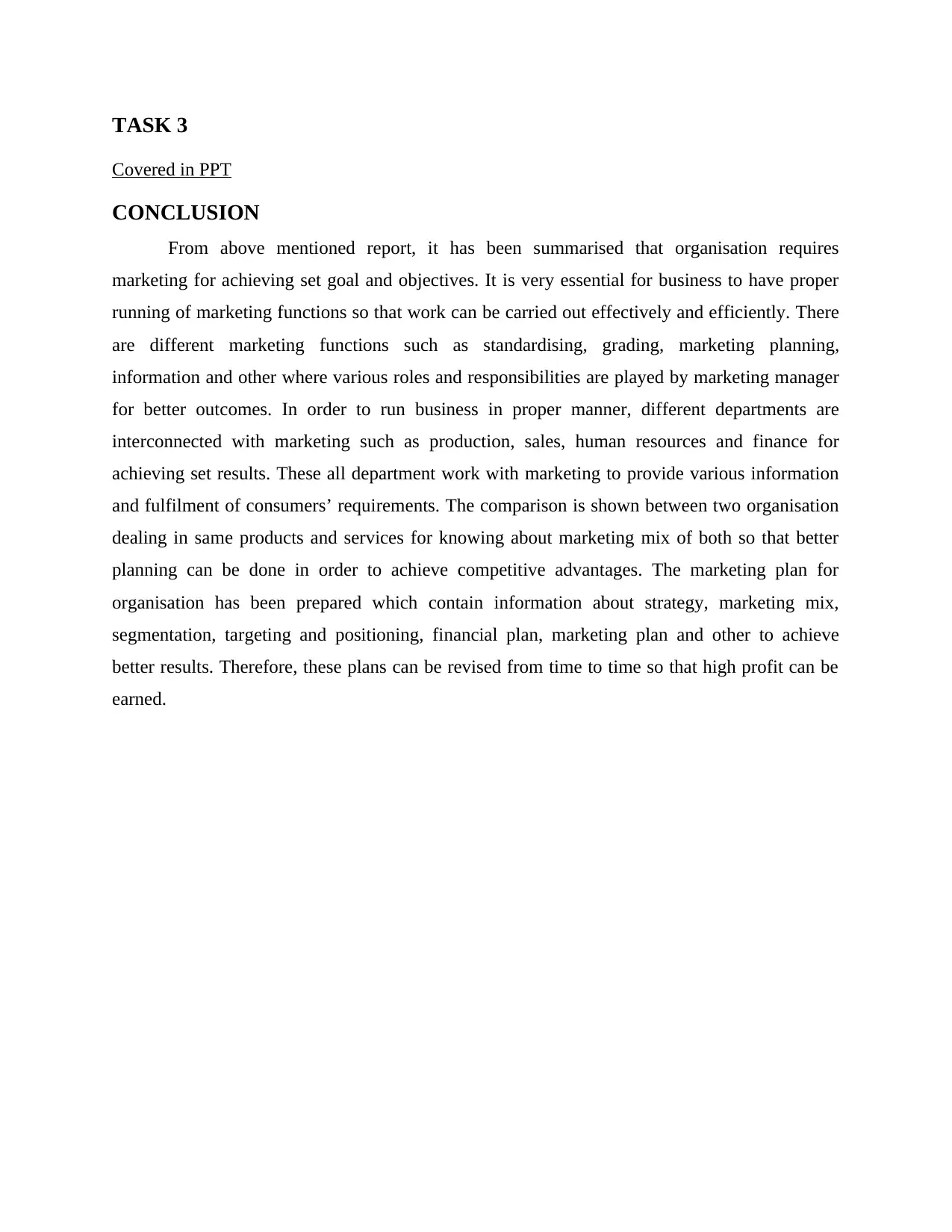
TASK 3
Covered in PPT
CONCLUSION
From above mentioned report, it has been summarised that organisation requires
marketing for achieving set goal and objectives. It is very essential for business to have proper
running of marketing functions so that work can be carried out effectively and efficiently. There
are different marketing functions such as standardising, grading, marketing planning,
information and other where various roles and responsibilities are played by marketing manager
for better outcomes. In order to run business in proper manner, different departments are
interconnected with marketing such as production, sales, human resources and finance for
achieving set results. These all department work with marketing to provide various information
and fulfilment of consumers’ requirements. The comparison is shown between two organisation
dealing in same products and services for knowing about marketing mix of both so that better
planning can be done in order to achieve competitive advantages. The marketing plan for
organisation has been prepared which contain information about strategy, marketing mix,
segmentation, targeting and positioning, financial plan, marketing plan and other to achieve
better results. Therefore, these plans can be revised from time to time so that high profit can be
earned.
Covered in PPT
CONCLUSION
From above mentioned report, it has been summarised that organisation requires
marketing for achieving set goal and objectives. It is very essential for business to have proper
running of marketing functions so that work can be carried out effectively and efficiently. There
are different marketing functions such as standardising, grading, marketing planning,
information and other where various roles and responsibilities are played by marketing manager
for better outcomes. In order to run business in proper manner, different departments are
interconnected with marketing such as production, sales, human resources and finance for
achieving set results. These all department work with marketing to provide various information
and fulfilment of consumers’ requirements. The comparison is shown between two organisation
dealing in same products and services for knowing about marketing mix of both so that better
planning can be done in order to achieve competitive advantages. The marketing plan for
organisation has been prepared which contain information about strategy, marketing mix,
segmentation, targeting and positioning, financial plan, marketing plan and other to achieve
better results. Therefore, these plans can be revised from time to time so that high profit can be
earned.
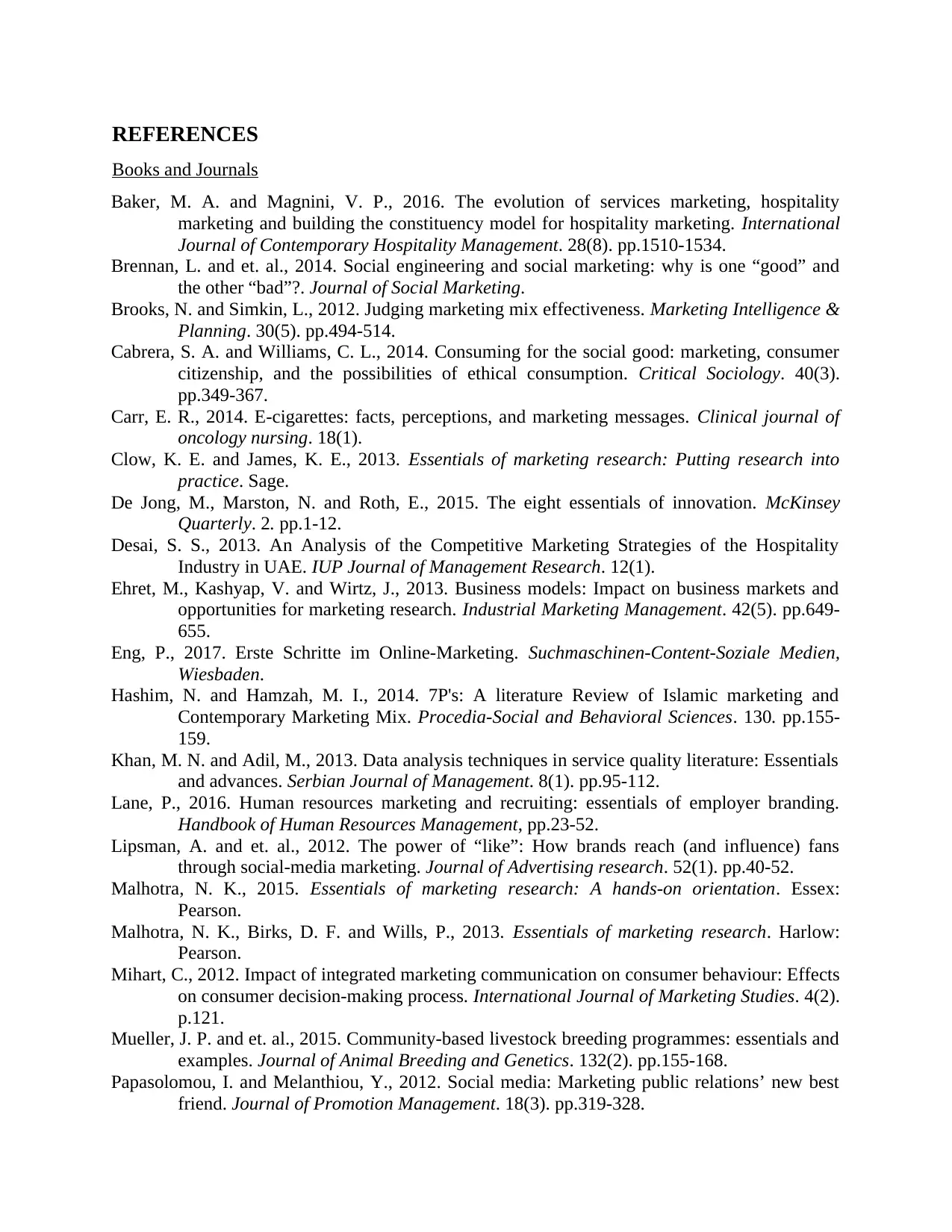
REFERENCES
Books and Journals
Baker, M. A. and Magnini, V. P., 2016. The evolution of services marketing, hospitality
marketing and building the constituency model for hospitality marketing. International
Journal of Contemporary Hospitality Management. 28(8). pp.1510-1534.
Brennan, L. and et. al., 2014. Social engineering and social marketing: why is one “good” and
the other “bad”?. Journal of Social Marketing.
Brooks, N. and Simkin, L., 2012. Judging marketing mix effectiveness. Marketing Intelligence &
Planning. 30(5). pp.494-514.
Cabrera, S. A. and Williams, C. L., 2014. Consuming for the social good: marketing, consumer
citizenship, and the possibilities of ethical consumption. Critical Sociology. 40(3).
pp.349-367.
Carr, E. R., 2014. E-cigarettes: facts, perceptions, and marketing messages. Clinical journal of
oncology nursing. 18(1).
Clow, K. E. and James, K. E., 2013. Essentials of marketing research: Putting research into
practice. Sage.
De Jong, M., Marston, N. and Roth, E., 2015. The eight essentials of innovation. McKinsey
Quarterly. 2. pp.1-12.
Desai, S. S., 2013. An Analysis of the Competitive Marketing Strategies of the Hospitality
Industry in UAE. IUP Journal of Management Research. 12(1).
Ehret, M., Kashyap, V. and Wirtz, J., 2013. Business models: Impact on business markets and
opportunities for marketing research. Industrial Marketing Management. 42(5). pp.649-
655.
Eng, P., 2017. Erste Schritte im Online-Marketing. Suchmaschinen-Content-Soziale Medien,
Wiesbaden.
Hashim, N. and Hamzah, M. I., 2014. 7P's: A literature Review of Islamic marketing and
Contemporary Marketing Mix. Procedia-Social and Behavioral Sciences. 130. pp.155-
159.
Khan, M. N. and Adil, M., 2013. Data analysis techniques in service quality literature: Essentials
and advances. Serbian Journal of Management. 8(1). pp.95-112.
Lane, P., 2016. Human resources marketing and recruiting: essentials of employer branding.
Handbook of Human Resources Management, pp.23-52.
Lipsman, A. and et. al., 2012. The power of “like”: How brands reach (and influence) fans
through social-media marketing. Journal of Advertising research. 52(1). pp.40-52.
Malhotra, N. K., 2015. Essentials of marketing research: A hands-on orientation. Essex:
Pearson.
Malhotra, N. K., Birks, D. F. and Wills, P., 2013. Essentials of marketing research. Harlow:
Pearson.
Mihart, C., 2012. Impact of integrated marketing communication on consumer behaviour: Effects
on consumer decision-making process. International Journal of Marketing Studies. 4(2).
p.121.
Mueller, J. P. and et. al., 2015. Community‐based livestock breeding programmes: essentials and
examples. Journal of Animal Breeding and Genetics. 132(2). pp.155-168.
Papasolomou, I. and Melanthiou, Y., 2012. Social media: Marketing public relations’ new best
friend. Journal of Promotion Management. 18(3). pp.319-328.
Books and Journals
Baker, M. A. and Magnini, V. P., 2016. The evolution of services marketing, hospitality
marketing and building the constituency model for hospitality marketing. International
Journal of Contemporary Hospitality Management. 28(8). pp.1510-1534.
Brennan, L. and et. al., 2014. Social engineering and social marketing: why is one “good” and
the other “bad”?. Journal of Social Marketing.
Brooks, N. and Simkin, L., 2012. Judging marketing mix effectiveness. Marketing Intelligence &
Planning. 30(5). pp.494-514.
Cabrera, S. A. and Williams, C. L., 2014. Consuming for the social good: marketing, consumer
citizenship, and the possibilities of ethical consumption. Critical Sociology. 40(3).
pp.349-367.
Carr, E. R., 2014. E-cigarettes: facts, perceptions, and marketing messages. Clinical journal of
oncology nursing. 18(1).
Clow, K. E. and James, K. E., 2013. Essentials of marketing research: Putting research into
practice. Sage.
De Jong, M., Marston, N. and Roth, E., 2015. The eight essentials of innovation. McKinsey
Quarterly. 2. pp.1-12.
Desai, S. S., 2013. An Analysis of the Competitive Marketing Strategies of the Hospitality
Industry in UAE. IUP Journal of Management Research. 12(1).
Ehret, M., Kashyap, V. and Wirtz, J., 2013. Business models: Impact on business markets and
opportunities for marketing research. Industrial Marketing Management. 42(5). pp.649-
655.
Eng, P., 2017. Erste Schritte im Online-Marketing. Suchmaschinen-Content-Soziale Medien,
Wiesbaden.
Hashim, N. and Hamzah, M. I., 2014. 7P's: A literature Review of Islamic marketing and
Contemporary Marketing Mix. Procedia-Social and Behavioral Sciences. 130. pp.155-
159.
Khan, M. N. and Adil, M., 2013. Data analysis techniques in service quality literature: Essentials
and advances. Serbian Journal of Management. 8(1). pp.95-112.
Lane, P., 2016. Human resources marketing and recruiting: essentials of employer branding.
Handbook of Human Resources Management, pp.23-52.
Lipsman, A. and et. al., 2012. The power of “like”: How brands reach (and influence) fans
through social-media marketing. Journal of Advertising research. 52(1). pp.40-52.
Malhotra, N. K., 2015. Essentials of marketing research: A hands-on orientation. Essex:
Pearson.
Malhotra, N. K., Birks, D. F. and Wills, P., 2013. Essentials of marketing research. Harlow:
Pearson.
Mihart, C., 2012. Impact of integrated marketing communication on consumer behaviour: Effects
on consumer decision-making process. International Journal of Marketing Studies. 4(2).
p.121.
Mueller, J. P. and et. al., 2015. Community‐based livestock breeding programmes: essentials and
examples. Journal of Animal Breeding and Genetics. 132(2). pp.155-168.
Papasolomou, I. and Melanthiou, Y., 2012. Social media: Marketing public relations’ new best
friend. Journal of Promotion Management. 18(3). pp.319-328.
⊘ This is a preview!⊘
Do you want full access?
Subscribe today to unlock all pages.

Trusted by 1+ million students worldwide
1 out of 15
Related Documents
Your All-in-One AI-Powered Toolkit for Academic Success.
+13062052269
info@desklib.com
Available 24*7 on WhatsApp / Email
![[object Object]](/_next/static/media/star-bottom.7253800d.svg)
Unlock your academic potential
Copyright © 2020–2025 A2Z Services. All Rights Reserved. Developed and managed by ZUCOL.





